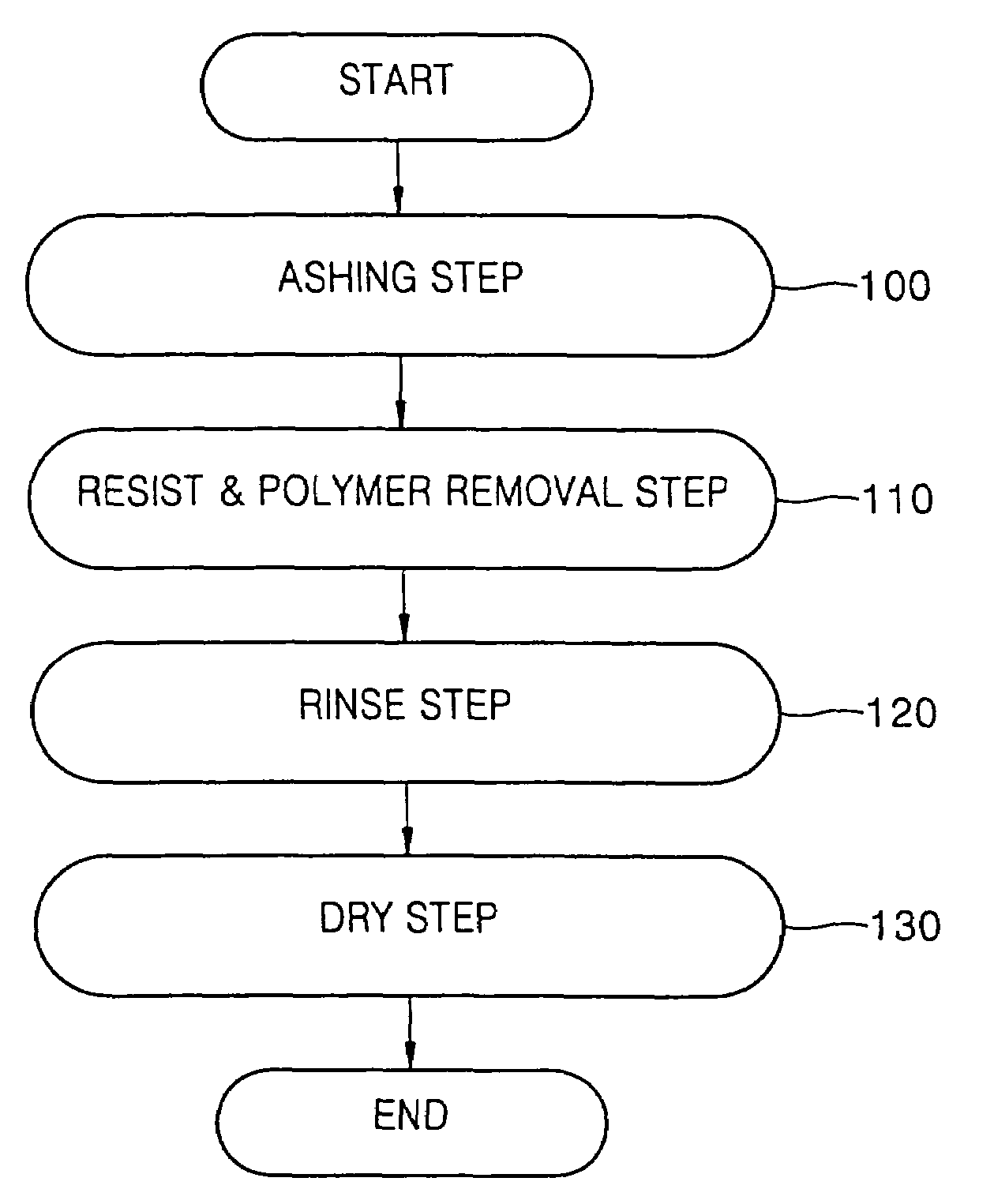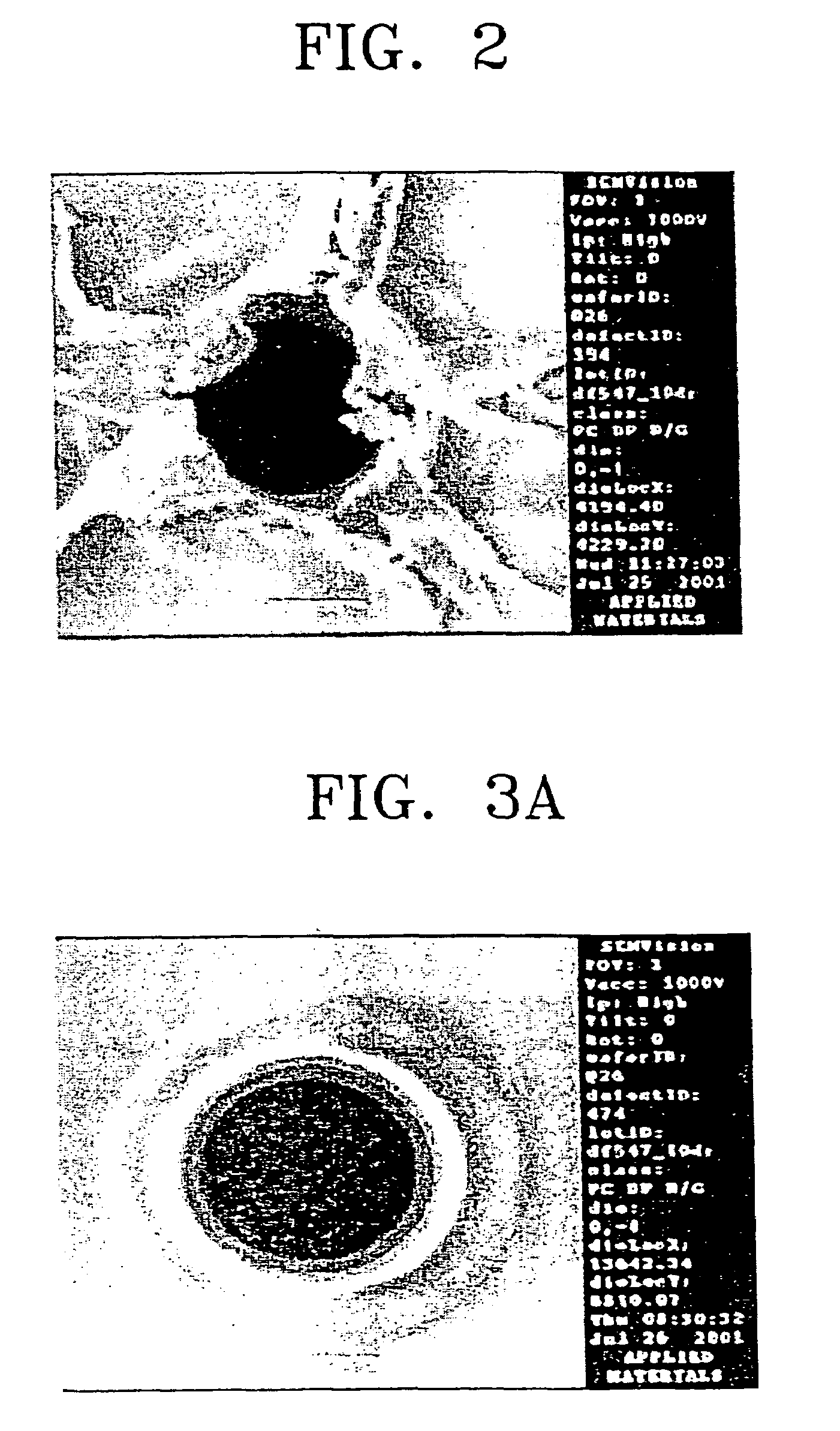Resist and etching by-product removing composition and resist removing method using the same
- Summary
- Abstract
- Description
- Claims
- Application Information
AI Technical Summary
Benefits of technology
Problems solved by technology
Method used
Image
Examples
example 1
[0062]This example illustrates the polymer removing capabilities of various compositions having different composition ratios. First, wafers for treatment of the compositions according to the present invention were prepared in the following manner. BoroPhosphoSilicate Glass (BPSG) layers were formed to a thickness of 5000 Å on a plurality of substrates, respectively. Then, a titanium layer and a titanium nitride layer were formed to a thickness of 200 Å, respectively, and annealed. Then, an aluminum layer was deposited to a thickness of 6000 Å and flowed. Next, a titanium nitride layer serving as a capping layer was formed on the aluminum layer, and an interlayer dielectric film was then formed to a thickness of 10000 Å. Then, a photoresist layer was coated on the interlayer dielectric film to a thickness of approximately 0.3 μm. Thereafter, the wafer coated with the resist composition for an ArF excimer laser was soft-baked at 130° C. for 90 seconds, exposed using an ArF excimer las...
example 2
[0067]This example discerns whether the compositions according to the present invention have interconnection layers that were attacked or not. In this example, wafers having vias were prepared in the same manner as in Example 1 and the compositions listed in Table 3 were employed. Then, the attacked states of interconnection layers, e.g., undercutting, were examined.
[0068]
TABLE 3Occurrence of UndercuttingOccurrenceCompo-HASMHPAH2OBTAMEAofsition(wt %)(wt %)(wt %)(wt %)(wt %)undercutting175934xxx2134641xxx31244404xx4838514xx5847396xx6757333xx7646434xx8641476xx911413737Δ107344649Δ1174134512Δ126523039Δ1363937415Δ1453337520Δ1575331x9◯16124338x7◯(An “∘” indicates that undercutting occurred,a “Δ” indicates that slight undercutting occurred, and an “x” indicates that no undercutting occurred.)
[0069]As shown in Table 3, when using the compositions according to the present invention, only a few of the interconnection layers were attacked as evidenced by the degree of undercutting. Even though...
example 3
[0070]This example illustrates a performance comparison between the composition according to the present invention, the conventional stripper A, and another conventional organic stripper (to be referred to as a stripper B).
[0071]The via having a width of 400–500 μm was formed in the same manner as in Example 1, and then an ashing step was performed. The top view of the resultant via was observed using SEM and the observation results are shown in FIG. 2, where it is seen that a large amount of polymer remains around the via circumference.
[0072]The wafer subjected to the ashing step was dipped into the composition according to the present invention at 65° C. for 20 minutes, rinsed with deionized water and then dried. Thereafter, the top view and cross-sectional view of the via were observed using SEM and the observation results are shown in FIGS. 3A and 3B.
[0073]The wafers subjected to the ashing step were dipped into the strippers A and B at 65° C. for 20 minutes, rinsed with deioniz...
PUM
| Property | Measurement | Unit |
|---|---|---|
| Fraction | aaaaa | aaaaa |
| Fraction | aaaaa | aaaaa |
| Fraction | aaaaa | aaaaa |
Abstract
Description
Claims
Application Information
 Login to View More
Login to View More - R&D
- Intellectual Property
- Life Sciences
- Materials
- Tech Scout
- Unparalleled Data Quality
- Higher Quality Content
- 60% Fewer Hallucinations
Browse by: Latest US Patents, China's latest patents, Technical Efficacy Thesaurus, Application Domain, Technology Topic, Popular Technical Reports.
© 2025 PatSnap. All rights reserved.Legal|Privacy policy|Modern Slavery Act Transparency Statement|Sitemap|About US| Contact US: help@patsnap.com



